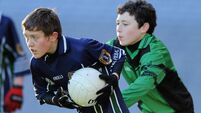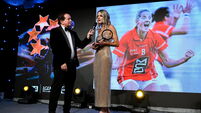Farewell to Tony Reddin - a true sporting legend

The only downside was that it diverted the spotlight away from the departure of a sporting legend during the week: Tony Reddin.
The name in itself evokes all the signifiers of the Munster championship. Hot afternoons in Thurles, a crowd massing over the railway bridge, and the hard goalmouth in Semple Stadium: Reddin’s canvas.
The Lorrha clubman’s selection on the Team of the Century and the Team of the Millennium was based largely on the series of games which helped to establish the Munster hurling final as a secular holy day for anyone interested in hurling — the clashes of Cork and Tipperary between 1949 and 1954.
In his book Christy Ring, author Val Dorgan summed up the feelings of thousands of opposing supporters — the fear of Reddin’s apparent coolness in the face of Cork’s forwards.
When Dorgan met Reddin years later he was surprised by the goalkeeper’s admission that he was nervous when Ring came marauding goalwards.
That never showed in his play. A judge of hurlers much respected by this column pointed out recently that Reddin invariably went “out the middle” with the ball.
The age-old advice to goalkeepers is to exit stage left, or right, sharply, but Reddin went straight out to clear: tough now, but inadvisable at a time when forwards invariably sought to put in a reducer on custodians.
Unlike modern goalkeepers, Reddin used a very heavy hurley with a smaller-than-average bas; its lack of wind resistance meant he could get that bas through the air a fraction of a second quicker to the ball.
He was so good that when he made a mistake it became a wonder — in 1954 he spilled the ball late on in the Munster final and Cork’s Paddy Barry hit the winning goal.
It would later emerge in mitigation that Cork’s Tom O’Sullivan, in challenging Reddin, had caught the ‘keeper on the funny bone, numbing his arm briefly.
Four years earlier he had stepped into legend when the Cork crowd invaded the field to get to him in another Munster final, and Reddin had to wait hours in the dressing-room until the crowd dispersed, only emerging from disguise when his getaway car was an hour out the road. Granted, yours truly can’t get enough of the heritage and history which surrounds hurling anyway, but Tony Reddin deserves a send-off.
I asked my mate who knew the great man to rank him in the pantheon of ‘keepers: “The best. No question. Out on his own.”
Good enough for me.
“BALLHOP...
Any sport with a special mud-rubbing technique is okay by me
You know me. I live to give. I was talking last week about Clive James — and the week before as well, but let’s not quibble — and this week I draw your attention to a daily mail-out from Dan Lewis, one called Now I Know.
The topics covered are diverse, but it caught my eye one day this week because it focused on a little-known activity in baseball.
America’s game is under a little pressure nowadays because of issues such as the drug problems of Alex Rodriguez, but one challenge is well in hand: that of keeping the baseballs dirty.
Lewis pointed out that at the top level, Major League Baseball uses 50 or 60 new balls in every game, but those new balls come with a coating that’s difficult for pitchers to grip.
As a result, they use special mud to make them a little grubby.
“Before each game,” wrote Lewis. “One of the umpires (or someone from the stadium staff) takes these five dozen or so balls and rubs each and every one of them with a Lena Blackburne Baseball Rubbing Mud, named for a coach who, apparently, discovered this special mud in the 1930s. Where did Blackburne find it? That’s a secret the company won’t share.”
The sharp-eyed among you will point out that the most obvious solution would be for the baseballs to be manufactured without that pesky coating, but that in turn would mean the special technique for rubbing would be redundant (“There’s a special technique to rubbing up a baseball. The mud — and a little water — goes on the leather, but not the seams...”)
I don’t know about you but any sport with a special mud-rubbing technique is okay by me. For more such information try NowIKnow.com
As this is something I intend to return to, I won’t belabour the point unnecessarily here. I’m just putting you on notice.
Last Saturday night, as I wandered around Croke Park looking for Jimmy Barry-Murphy and Ger Cunningham after Cork played Dublin, I ended up with the other members of the fourth estate in the auditorium next to the GAA Museum under the Cusack Stand.
What I found particularly interesting was the copy of the event management handbook on the main desk at the head of the little lecture theatre. Or rather the size of it, and the amount of detail crammed into it.
It hardly comes as a surprise to anyone that a great deal of organisation goes into a big event which attracts thousands of people to a venue, but a full 39 pages of details? To be continued...
After Saturday night, I hit for Galway, suffering a little after staying on that cruel half-hour too late in an establishment in the capital where a man had a very interesting story about a birthday cake, an All-Star hurler, a dickie bow and very little else...
Anyway, I was rumbling around the City of the Tribes doing a little grumbling (surely some mistake — all known acquaintances) when I stumbled across one of the gems of the west, Charlie Byrne’s Bookshop.
Once inside, I came across a pearl which I clasped to my bosom immediately: a hardback copy of Kingsley Amis’s memoirs, a book I have sought lo these many years. The fact that it was signed only made my heart sing all the more. I am putting this on the record here to a) signify my delight b) to thank the staff of said bookstore and c) to indicate to all who know me that no negotiations for a loan will be entertained.












